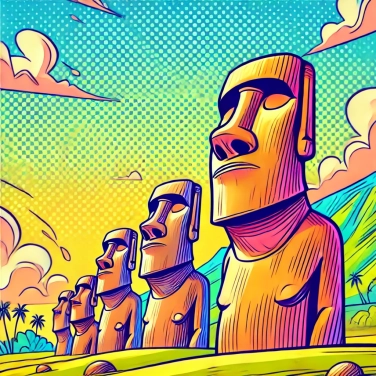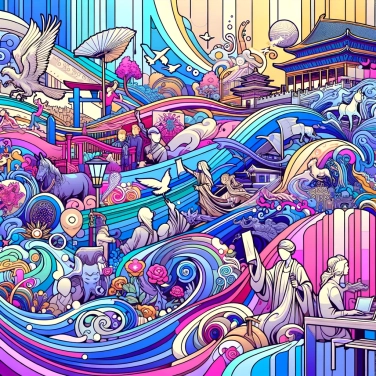The statues on Easter Island are called Moai in reference to the deified ancestors of Rapa Nui culture.

The word Moaï comes directly from the language of the island's original inhabitants, the Rapa Nui people. This term simply means "statue" or "figure" in their dialect. These immense sculptures made of volcanic rock began to be carved around the 13th century, at a time when the Rapa Nui civilization was flourishing. Originally, these stone giants were not just called statues: for the inhabitants, they primarily represented the sacred ancestors, a sort of silent guardians watching over their territory. It is therefore natural that the ancient Rapa Nui chose a simple, effective, and symbolic term to identify these colossal figures.
The term Moaï comes directly from the language of the Rapa Nui, the indigenous people of Easter Island. This Polynesian language uses the word moaï to simply refer to a statue or a sculpted representation. In the local culture, the moaï represent the revered ancestors who, once deceased, continue to protect the community. This simple word then crossed the oceans to become internationally known thanks to these mysterious monumental faces facing the island.
The word Moaï simply means statue or figure in the language of the inhabitants of Easter Island, the Rapa Nui people. But it goes a bit beyond that. In reality, a Moaï is the image of an important ancestor or a respected chief that was meant to be honored. By erecting these enormous statues, the inhabitants believed they would protect the community, bring fertility, and maintain the precious connection between the living and their deceased ancestors. A Moaï is thus much more than just a giant statue carved from stone: it is a sacred presence filled with spiritual strength and respect, a powerful entity that symbolized the very identity of the Rapa Nui people.
The first Europeans arrived on Easter Island in 1722, led by the Dutch explorer Jacob Roggeveen. However, they did not immediately grasp the word Moaï. It was only from the mid-19th century, with travelers like the French explorer Pierre Loti, that the term really began to circulate outside the island. Later, in the 1950s and 1960s, archaeological expeditions made the statues famous worldwide, definitively popularizing the term Moaï among the general public. Today, this word has become the essential reference when talking about these mysterious giants.
Between the 15th and 17th centuries, it is estimated that over 900 Moai statues were sculpted by the inhabitants of Easter Island in the volcanic quarry of Rano Raraku.
The manufacturing and transportation of the Moai statues remain shrouded in mystery, although researchers now believe that they were moved using ropes and coordinated tilting techniques, a method known as 'walking the Moai.'
The vast majority of the Moai face inland, likely symbolizing the protection of the inhabitants and villages, with the exception of the group at Ahu Akivi, whose statues look out towards the ocean.
The largest Moai ever erected, named 'Paro', stands about 10 meters tall and weighs approximately 82 tons.
According to researchers, the statues were toppled mainly due to internal conflicts between clans or groups on the island. The fall of the Moai would symbolize the overthrow of the spiritual and political power of various rival groups during a period of social crisis.
The vast majority of Moai statues were carved from volcanic tuff, a porous rock formed by the accumulation of compacted volcanic ash. A few rare statues were shaped from harder materials, such as basalt.
The Moai represent protective ancestors believed to watch over the inhabitants of the villages. Therefore, they are generally oriented towards the land to symbolize protection and benevolence towards their community rather than towards the ocean.
Today, there are nearly 900 Moai statues on the island, in various states of completion and preservation. Some stand upright on their ceremonial platforms called ahu, while others remain unfinished in the quarries where they were carved.
The Moai statues were built by the Rapa Nui civilization, the original Polynesian inhabitants of Easter Island, between the 13th and 16th centuries. These stone sculptures represent the deified ancestors of the local clans.

50% of respondents passed this quiz completely!
Question 1/5